Improvement of Recycled Aggregates Properties by Means of CO2 Uptake
Abstract
:1. Introduction
2. Research Significance
- The new calculation of CO2 uptake, taking into account the water generated by the carbonation of portlandite;
- The identification of a relationship between the RCA’s optimum water content and their WAC for a maximum CO2 uptake. This study shows the range of optimum water content related to the WAC of RCAs, with many of them being from laboratory concretes or from old demolition concretes. This data are important for industrial applications. This interval is known in the literature in concretes (around 65% and 80% in relative humidity), but these values are not transposable to RCAs. This study proposes a process of imposing the optimum water content by impregnation and drying. This process generates the saturated surface dry state of RCAs and good filling of the pores by water for an optimal diffusion of CO2;
- The contribution of accelerated carbonation compared to natural carbonation for RCAs from recycling platforms, which has not been shown in the literature;
- The range of pores clogged by CaCO3 and the range of pores formed after carbonation, derived to be essential data for the durability of carbonated RCAs. These tests with mercury intrusion porosimetry are related to the decrease of the WAC on the same RCA (RB 1–4 C).
3. Materials and Methods
3.1. Materials
- RB 1–4, which was the 1–4 mm fraction, was naturally carbonated after crushing and 6 years of storage under natural conditions. The thermogravimetric analysis (TGA), therefore, did not reveal the presence of portlandite (Table 1);
- RB 10–20, which was the 10–20 mm fraction, was naturally carbonated only on the surface;
- RB 1–4 C, which was a 1–4 mm fraction obtained by crushing RB 10–20, was used to study the effect of the initial natural carbonation status of RB 1–4 on the CO2 uptake.
3.2. Accelerated Carbonation Test on RCAs
3.3. Effect of the Temperature on the Accelerated Carbonation of RCAs
3.4. Determination of CO2 Uptake by the RCAs
3.5. Determination of the Water Absorption Coefficient of the RCAs
3.6. Evaluation of the Pore Size Distributions of the RCAs
4. Results and Discussions
4.1. Parametric Study of the Accelerated Carbonation Test on RCAs
4.1.1. Effect of the Initial Natural Carbonation of an RCA on the CO2 Uptake
4.1.2. Effect of the CO2 Concentration on the CO2 Uptake
4.1.3. Effect of the RCA Type on CO2 Uptake
4.1.4. Effect of the RCA Size on the CO2 Uptake
4.1.5. Effect of the Temperature on the CO2 Uptake
4.1.6. Correlation between the Optimum Water Content and the Water Absorption Coefficient of the RCA
4.2. Impact of Accelerated Carbonation on the Properties of RCAs
4.2.1. Impact of Natural and Accelerated Carbonation on the Water Absorption Coefficient
4.2.2. Effect of the CO2 Concentration on the CO2 Uptake and Water Absorption Coefficient
4.2.3. Changes in the Pore Size Distribution of an RCA by Mercury Intrusion Porosimetry
- 3.7–30 nm: micropores (pores between C–S–H gels and capillary micropores);
- 30–220 nm: capillary pores;
- 220–10,000 nm: macropores;
- Pores >10,000 nm: large pores (air bubbles due to production of the concrete).
5. Conclusions
- For each carbonation test, water content is the most important parameter for reaching an effective rate of CO2 uptake, whatever the studied parameter;
- The maximum CO2 uptake is 50 g/kg for CB 1–4 because they are not carbonated at the initial state, and the minimum is for RB 1–4 (8.6 g/kg) because of the initial natural carbonation. The mean of CO2 uptake was around 15–20 g/kg for the studied RCAs;
- The correlation between the optimum water content and the water absorption coefficient is important for effective carbonation. To obtain the maximum CO2 uptake, it is necessary to have an optimum water content equal to 80% of the RCA’s water absorption coefficient. This conclusion is important for industrial applications;
- Carbonation decreases the WAC by filling pores due to the formation of calcium carbonates. CO2 uptake during treatment could decrease the WAC by up to 39% in the case of RB 1–4 C (AC), while natural carbonation could decrease the WAC by up to 48% after 6 years of storage, as was observed for NC–RB 1–4;
- Finally, carbonation leads to the formation of calcium carbonates and to a decrease in total porosity. The capillary porosity is decreased due to clogging of the pores. In addition, carbonation increases the microporosity of an RCA, especially the porosity of the C–S–H gel, as a result of decalcification.
Author Contributions
Funding
Acknowledgments
Conflicts of Interest
References
- Yap, S.P.; Goh, Y.; Mo, K.H.; Ibrahim, H.A. Recycling of construction and demolition wastes into renewable construction materials. Ency. Ren. Sust. Mat. 2019, 2, 520–526. [Google Scholar] [CrossRef]
- Afnor. NF EN 206/CN: Concrete–Specification, Performance, Production and Conformity–National Addition to the Standard NF EN 206; Afnor: Kent, UK, 2014. [Google Scholar]
- De Brito, J.; Saikia, N. Recycled Aggregate in Concrete-Use of Industrial, Construction and Demolition Waste; Springer: Berlin/Heidelberg, Germany, 2013. [Google Scholar]
- De Juan, M.S.; Gutiérrez, P.A. Study on the influence of attached mortar content on the properties of recycled concrete aggregate. Constr. Build. Mat. 2009, 23, 872–877. [Google Scholar] [CrossRef]
- Omary, S.; Ghorbel, E.; Wardeh, G. Relationships between recycled concrete aggregates characteristics and recycled aggregates concretes properties. Constr. Build. Mat. 2016, 108, 163–174. [Google Scholar] [CrossRef]
- Verian, K.P.; Ashraf, W.; Cao, Y. Properties of recycled concrete aggregate and their influence in new concrete production. Res. Cons. Recycl. 2018, 133, 30–49. [Google Scholar] [CrossRef]
- Barra, M.; Vasquez, E. Properties of concretes with recycled aggregates: Influence of properties of the aggregats and their interpretation. In Proceedings of the International Symposium on Sustainable Construction: Use of Recycled Concrete Aggregate, London, UK, 11–12 November 1998; ICE Publishing: London, UK, 2015; pp. 558–563. [Google Scholar]
- De Brito, J.; Ferreira, J.; Pacheco, J.; Soares, D.; Guerreiro, M. Structural, material, mechanical and durability properties and behaviour of recycled aggregates concrete. J. Build. Eng. 2016, 6, 1–16. [Google Scholar] [CrossRef]
- Zega, C.J.; Di Maio, A.A. Use of recycled fine aggregate in concretes with durable requirements. Waste Manag. 2011, 31, 2336–2340. [Google Scholar] [CrossRef] [PubMed] [Green Version]
- Duan, Z.H.; Poon, C.S. Properties of recycled aggregate concrete made with recycled aggregates with different amounts of old adhered mortars. Mat. Design 2014, 58, 19–29. [Google Scholar] [CrossRef]
- Dimitriou, G.; Savva, P.; Petrou, M.F. Enhancing mechanical and durability properties of recycled aggregate concrete. Constr. Build. Mat. 2018, 158, 228–235. [Google Scholar] [CrossRef]
- Gholampour, A.; Ozbakkaloglu, T. Time-dependent and long-term mechanical properties of concretes incorporating different grades of coarse recycled concrete aggregates. Eng. Struct. 2018, 157, 224–234. [Google Scholar] [CrossRef]
- Ozbakkaloglu, T.; Gholampour, A.; Xie, T. Mechanical and Durability Properties of Recycled Aggregate Concrete: Effect of Recycled Aggregate Properties and Content. J. Mat. Civil Eng. 2017, 30, 1–13. [Google Scholar] [CrossRef]
- Kumar, R.; Gurram, S.C.B.; Minocha, A.K. Influence of recycled fine aggregate on microstructure and hardened properties of concrete. Mag. Concr. Res. 2017, 69, 1288–1295. [Google Scholar] [CrossRef]
- Etxeberria, M.; Vasquez, E.; Mari, A.; Barra, M. Influence of amount of recycled coarse aggregates and production process on properties of recycled aggregate concrete. Cem. Concr. Res. 2007, 37, 735–742. [Google Scholar] [CrossRef]
- Evangelista, L.; De Brito, J. Mechanical behaviour of concrete made with fine recycled concrete aggregates. Cem. Concr. Comp. 2007, 29, 397–401. [Google Scholar] [CrossRef]
- Ismail, S.; Kwan, W.H.; Ramli, M. Mechanical strength and durability properties of concrete containing treated recycled concrete aggregates under different curing conditions. Constr. Build. Mat. 2017, 155, 296–306. [Google Scholar] [CrossRef]
- Thomas, C.; Setién, J.; Polanco, J.A.; Alaejos, P.; De Juan, M.S. Durability of recycled aggregate concrete. Constr. Build. Mat. 2013, 40, 1054–1065. [Google Scholar] [CrossRef]
- Xiao, J.; Li, W.; Poon, C. Recent studies on mechanical properties of recycled aggregate concrete in China-A review. Sci. China Tech. Sci. 2012, 55, 1463–1480. [Google Scholar] [CrossRef]
- Kwan, W.H.; Ramli, M.; Kam, K.J.; Sulieman, M.Z. Influence of the amount of recycled coarse aggregate in concrete design and durability properties. Constr. Build. Mat. 2012, 26, 565–573. [Google Scholar] [CrossRef]
- Erdem, S.; Blankson, M.A. Environmental performance and mechanical analysis of concrete containing recycled asphalt pavement (RAP) and waste precast concrete as aggregate. J. Hazard. Mat. 2014, 264, 403–410. [Google Scholar] [CrossRef]
- De Larrard, F.; Colina, H. Concrete Recycling: Research and Practice (Ouvrage de synthèse du PN RecyBéton); CRC Press: Boca Raton, FL, USA, 2018. [Google Scholar]
- Shi, C.; Li, Y.; Zhang, J.; Li, W.; Chong, L.; Xie, Z. Performance enhancement of recycled concrete aggregate–A review. J. Clean. Prod. 2016, 112, 466–472. [Google Scholar] [CrossRef]
- Zhang, D.; Cai, X.; Shao, Y. Carbonation curing of precast fly ash concrete. J. Mat. Civil Eng. 2016, 28. [Google Scholar] [CrossRef]
- United Nations. Report of the Conference of the Parties on Its Twenty-First Session, Held in Paris from 30 November to 13 December 2015-Part Two: Action Taken by the Conference of the Parties at Its Twenty-First Session; Report n°FCCC/CP/2015/10/Add.1; United Nations: New York, NY, USA, 2016. [Google Scholar]
- Miricioiu, M.G.; Niculescu, V.-C.; Filote, C.; Raboaca, M.; Nechifor, G. Coal fly ash derived silica nanomaterial for MMMS–Application in CO2/CH4 Separation. Membranes 2021, 11, 78. [Google Scholar] [CrossRef] [PubMed]
- Miricioiu, M.G.; Niculescu, V.-C. Fly ash, from recycling to potential raw material for mesoporous silica synthesis. Nanomaterials 2020, 10, 474. [Google Scholar] [CrossRef] [Green Version]
- Zhan, B.; Poon, C.S.; Liu, Q.; Kou, S.C.; Shi, C. Experimental study on CO2 curing for enhancement of recycled aggregate properties. Constr. Build. Mat. 2014, 67, 3–7. [Google Scholar] [CrossRef]
- Fang, X.; Xuan, D.; Poon, C.S. Empirical modelling of CO2 uptake by recycled concrete aggregates under accelerated carbonation conditions. Mat. Struct. 2017, 50, 200–212. [Google Scholar] [CrossRef]
- Pan, G.; Zhan, M.; Fu, M.; Wang, Y.; Lu, X. Effect of CO2 curing on demolition recycled fine aggregates enhanced by calcium hydroxide pre-soaking. Constr. Build. Mat. 2017, 154, 810–818. [Google Scholar] [CrossRef]
- Pu, Y.; Li, L.; Wang, Q.; Shi, X.; Luan, C.; Zhang, G.; Fu, L.; El-Fatah Abomohra, A. Accelerated carbonation technology for enhanced treatment of recycled concrete aggregates: A state-of-the-art review. Constr. Build. Mat. 2021, 282, 122671. [Google Scholar] [CrossRef]
- Quattrone, M.; Cazacliu, B.; Angulo, S.C.; Hamard, E.; Cothenet, A. Measuring the water absorption of recycled aggregates, what is the best practice for concrete production? Constr. Build. Mat. 2016, 123, 690–703. [Google Scholar] [CrossRef]
- Xuan, D.; Zhan, B.; Poon, C.S. Assessment of mechanical properties of concrete incorporating carbonated recycled concrete aggregates. Cem. Concr. Compos. 2016, 65, 67–74. [Google Scholar] [CrossRef]
- Xuan, D.; Zhan, B.; Poon, C.S. Development of a new generation of eco-friendly concrete blocks by accelerated mineral carbonation. J. Clean. Prod. 2016, 133, 1235–1241. [Google Scholar] [CrossRef]
- Kikuchi, T.; Kuroda, Y. Carbon dioxide uptake in demolished and crushed concrete. J. Adv. Concr. Tech. 2011, 9, 115–124. [Google Scholar] [CrossRef] [Green Version]
- Kaliyavaradhan, S.K.; Ling, T.-C. Potential of CO2 sequestration through construction and demolition (C&D) waste—An overview. J. CO2 Util. 2017, 20, 234–242. [Google Scholar] [CrossRef]
- Liang, C.; Pan, B.; Ma, Z.; He, Z.; Duan, Z. Utilization of CO2 curing to enhance the properties of recycled aggregate and prepared concrete: A review. Cem. Concr. Comp. 2020, 105, 103446. [Google Scholar] [CrossRef]
- Wang, D.; Noguchi, T.; Nozaki, T. Increasing efficiency of carbon dioxide sequestration through high temperature carbonation of cement-based materials. J. Clean. Prod. 2019, 238, 117980. [Google Scholar] [CrossRef]
- Drouet, E.; Poyet, S.; Le Bescop, P.; Torrenti, J.-M.; Bourbon, X. Carbonation of hardened cement pastes: Influence of temperature. Cem. Concr. Res. 2019, 115, 445–459. [Google Scholar] [CrossRef] [Green Version]
- Wang, J.; Xu, H.; Xu, D.; Du, P.; Zhou, Z.; Yuan, L.; Cheng, X. Accelerated carbonation of hardened cement pastes: Influence of porosity. Constr. Build. Mat. 2019, 225, 159–169. [Google Scholar] [CrossRef]
- Collectif Presses de l’école nationale des ponts et chaussées. In Synthèse des Travaux du Projet National BHP 2000 sur les Bétons à Hautes Performances; Presses de l’école nationale des ponts et chaussées: Paris, France, 2005. (In French)
- Afnor. NF 1097-6: Tests for Mechanical and Physical Properties of Aggregates-Part 6: Determination of Particle Density and Water Absorption; Afnor: Kent, UK, 2014. [Google Scholar]
- Yacoub, A.; Djerbi, A.; Fen-Chong, T. Water absorption in recycled sand: New experimental methods to estimate the water saturation degree and kinetic filling during mortar mixing. Constr. Build. Mat. 2018, 158, 464–471. [Google Scholar] [CrossRef]
- Zhao, Z.; Remond, S.; Damidot, D.; Xu, W. Influence of hardened cement paste content on the water absorption of fine recycled concrete aggregates. J. Sust. Cement-Based Mat. 2013, 2, 186–203. [Google Scholar] [CrossRef]
- Sereng, M. Amélioration des propriétés des granulats recyclés par stockage de CO2: Étude de la faisabilité préindustrielle. Ph.D. Thesis, University Paris-Est, Paris, France, 2020. (In French). [Google Scholar]
- Morandeau, A.; Thiéry, M.; Dangla, P. Investigation of the carbonation mechanism of CH and C–S–H in terms of kinetics, microstructure changes and moisture properties. Cem. Concr. Res. 2014, 56, 153–170. [Google Scholar] [CrossRef] [Green Version]
- Djerbi Tegguer, A. Determining the water absorption of recycled aggregates utilizing hydrostatic weighing approach. Constr. Build. Mat. 2012, 27, 112–116. [Google Scholar] [CrossRef]
- Yacoub, A.; Djerbi, A.; Fen-Chong, T. The effect of the drying temperature on water porosity and gas permeability of recycled sand mortar. Constr. Build. Mat. 2019, 214, 677–684. [Google Scholar] [CrossRef]
- Zhang, Z.; Pan, S.-Y.; Li, H.; Cai, J.; Olabi, A.; Anthony, E.J.; Manovic, V. Recent advances in carbon dioxide utilization. Ren. Sustain. Energy Rev. 2020, 125, 109799. [Google Scholar] [CrossRef]
- Baldelli, A.; Esmeryan, K.D.; Popovicheva, O. Turning a negative into a positive: Trends, guidelines and challenges of developing multifunctional non-wettable coatings based on industrial soot wastes. Fuel 2021, 301, 121068. [Google Scholar] [CrossRef]
- Zhang, J.; Shi, C.; Li, Y.; Pan, X.; Poon, C.S.; Xie, Z. Influence of carbonated recycled concrete aggregate on properties of cement mortar. Constr. Build. Mat. 2015, 98, 1–7. [Google Scholar] [CrossRef]
- Li, Y.K. Improvement of Recycled Concrete Aggregate Properties by CO2 Curing. Ph.D. Thesis, Hunan University, Changsha, China, 2014. [Google Scholar]
- Zhan, B.J.; Xuan, D.X.; Poon, C.S.; Shi, C.J. Mechanism for rapid hardening of cement pastes under coupled CO2-water curing regime. Cem. Concr. Comp. 2019, 97, 78–88. [Google Scholar] [CrossRef]
- Fang, X.; Zhan, B.; Poon, C.S. Enhancing the accelerated carbonation of recycled concrete aggregates by using reclaimed wastewater from concrete batching plants. Constr. Build. Mat. 2020, 239, 117810. [Google Scholar] [CrossRef]
- Xuan, D.; Zhan, B.; Poon, C.S. Durability of recycled aggregate concrete prepared with carbonated recycled concrete aggregates. Cem. Concr. Comp. 2017, 84, 214–221. [Google Scholar] [CrossRef]
- Li, Y.; Fu, T.; Wang, R.; Li, Y. An assessment of microcracks in the interfacial transition zone of recycled concrete aggregates cured by CO2. Constr. Build. Mat. 2020, 236, 117543. [Google Scholar] [CrossRef]
- Fernandez Bertos, M.; Simons, S.J.R.; Hills, C.D.; Carey, P.J. A review of accelerated carbonation technology in the treatment of cement-based materials and sequestration of CO2. J. Hazard. Mat. 2004, 112, 193–205. [Google Scholar] [CrossRef]
- Goñi, S.; Gaztañaga, M.T.; Guerrero, A. Role of cement type on carbonation attack. J. Mat. Sci. 2002, 17, 1834–1842. [Google Scholar] [CrossRef]
- Saillio, M.; Baroghel-Bouny, V.; Pradelle, S. Effect of carbonation on durability indicators and microstructure in cement pastes and concretes with supplementary cementitious materials. In Proceedings of the Fib Symposium, Cape Town, South Africa, 21–23 November 2016. [Google Scholar]
- Houst, Y.F. Carbonation shrinkage of hydrated cement paste. In Proceedings of the 4th CANMET/ACI International Conference on Durability of Concrete, 1997; American Concrete Institute: Farmington Hills, MI, USA, 1997; pp. 481–491. [Google Scholar]
- Auroy, M.; Poyet, S.; Le Bescop, P.; Torrenti, J.-M.; Charpentier, T.; Moskura, M.; Bourbon, X. Impact of carbonation on unsaturated water transport properties of cement-based materials. Cem. Concr. Res. 2015, 74, 44–58. [Google Scholar] [CrossRef]
- Wu, B.; Ye, G. Development of porosity of cement paste blended with supplementary cementitious materials after carbonation. Constr. Build. Mat. 2017, 145, 52–61. [Google Scholar] [CrossRef] [Green Version]
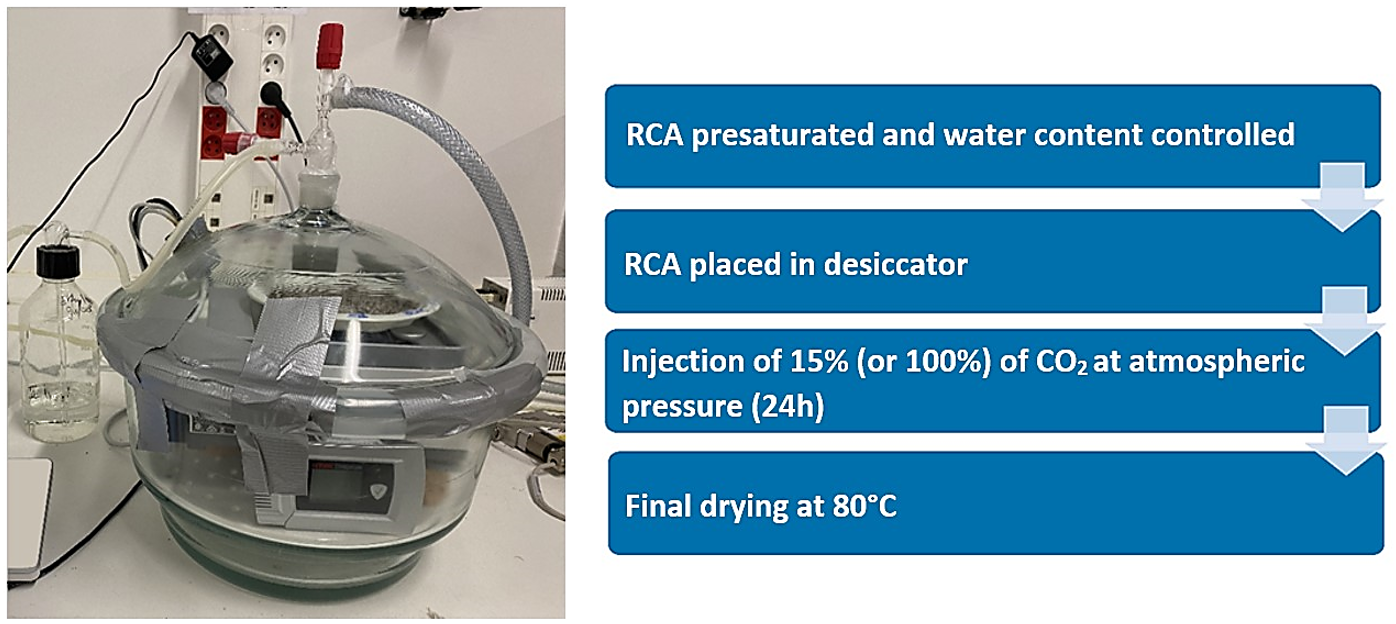
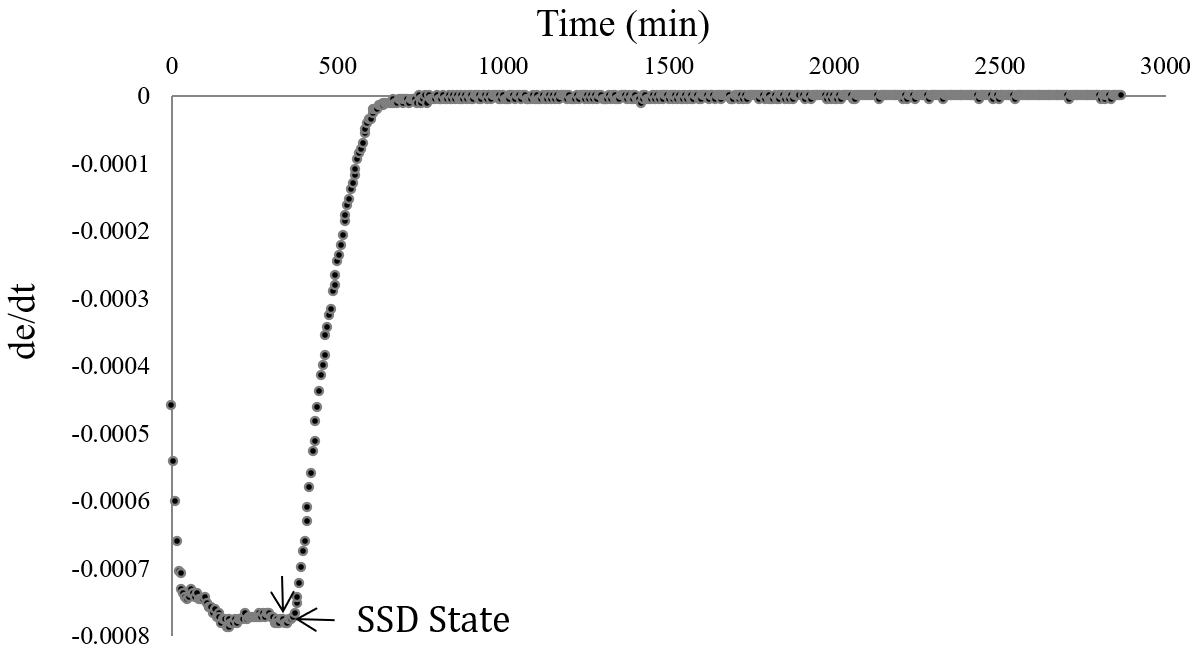

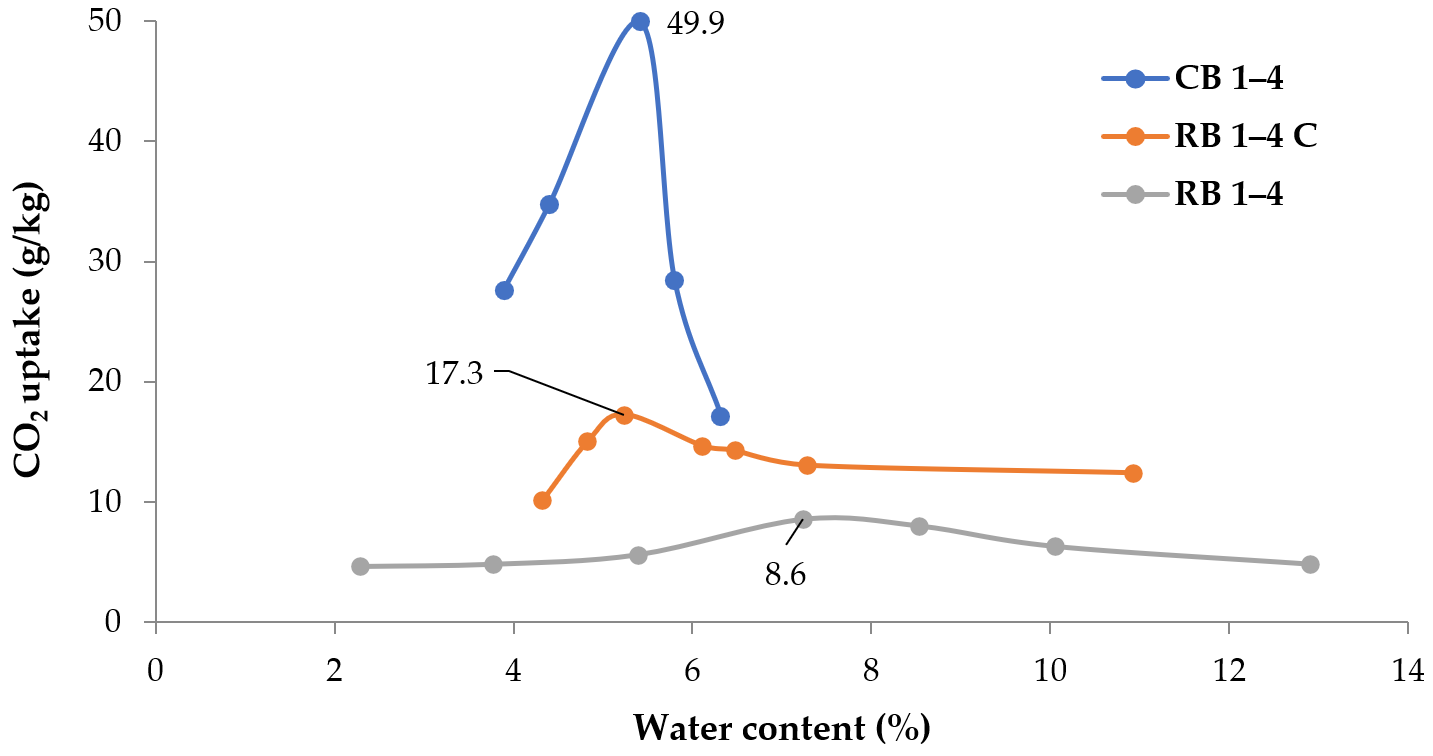
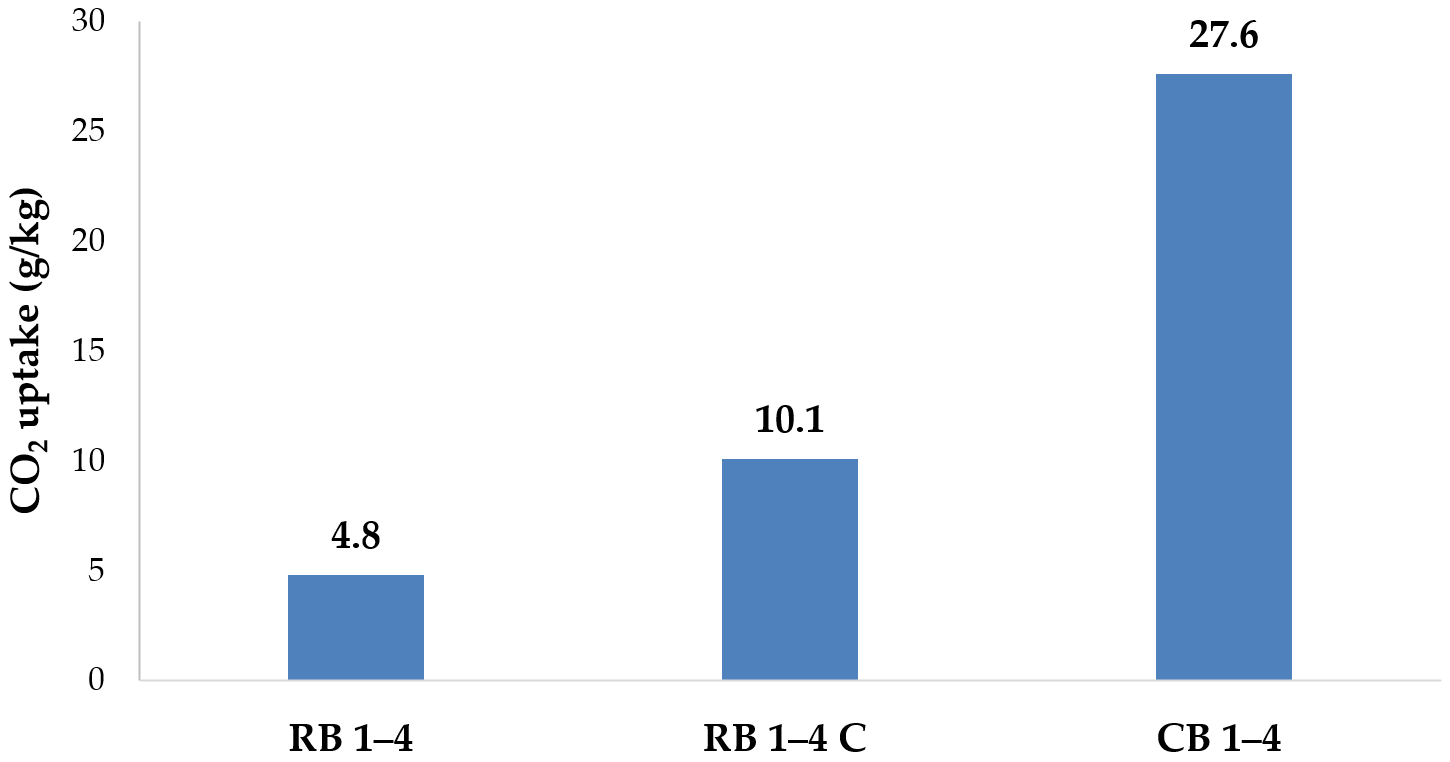
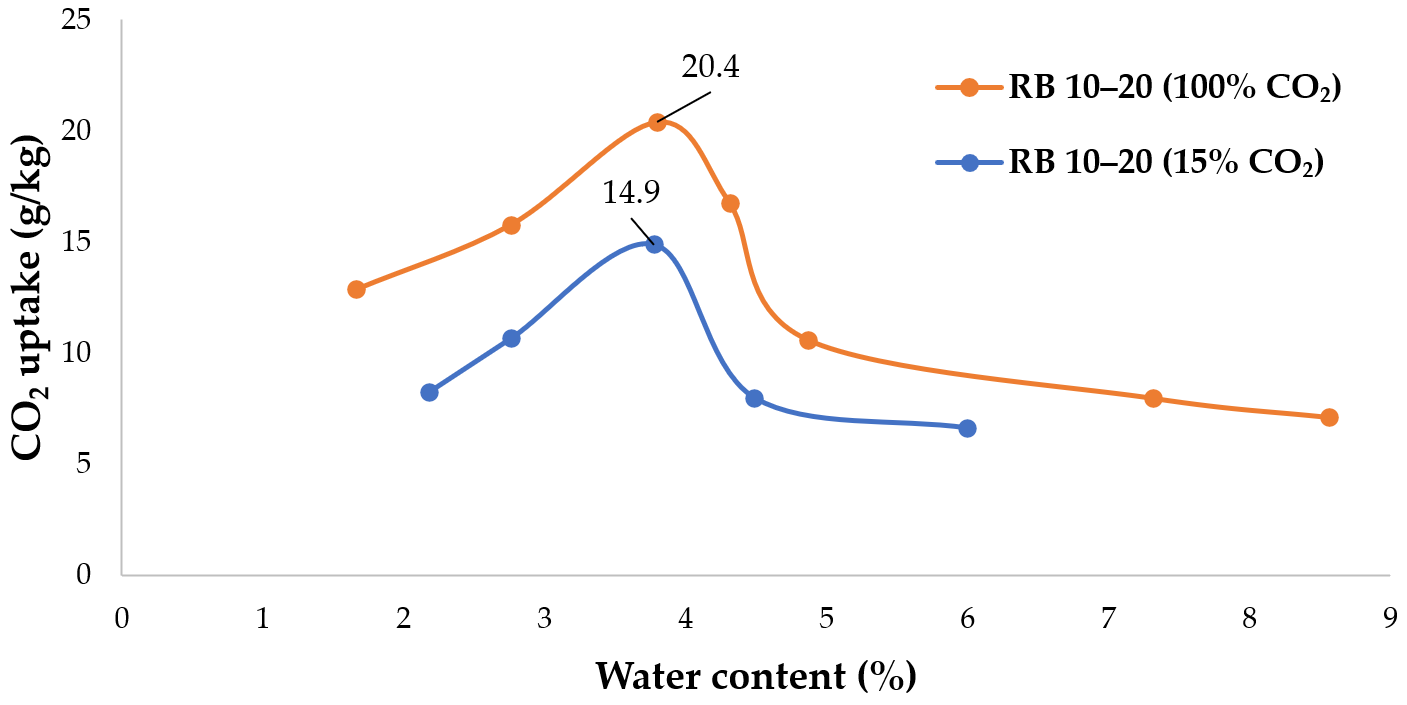
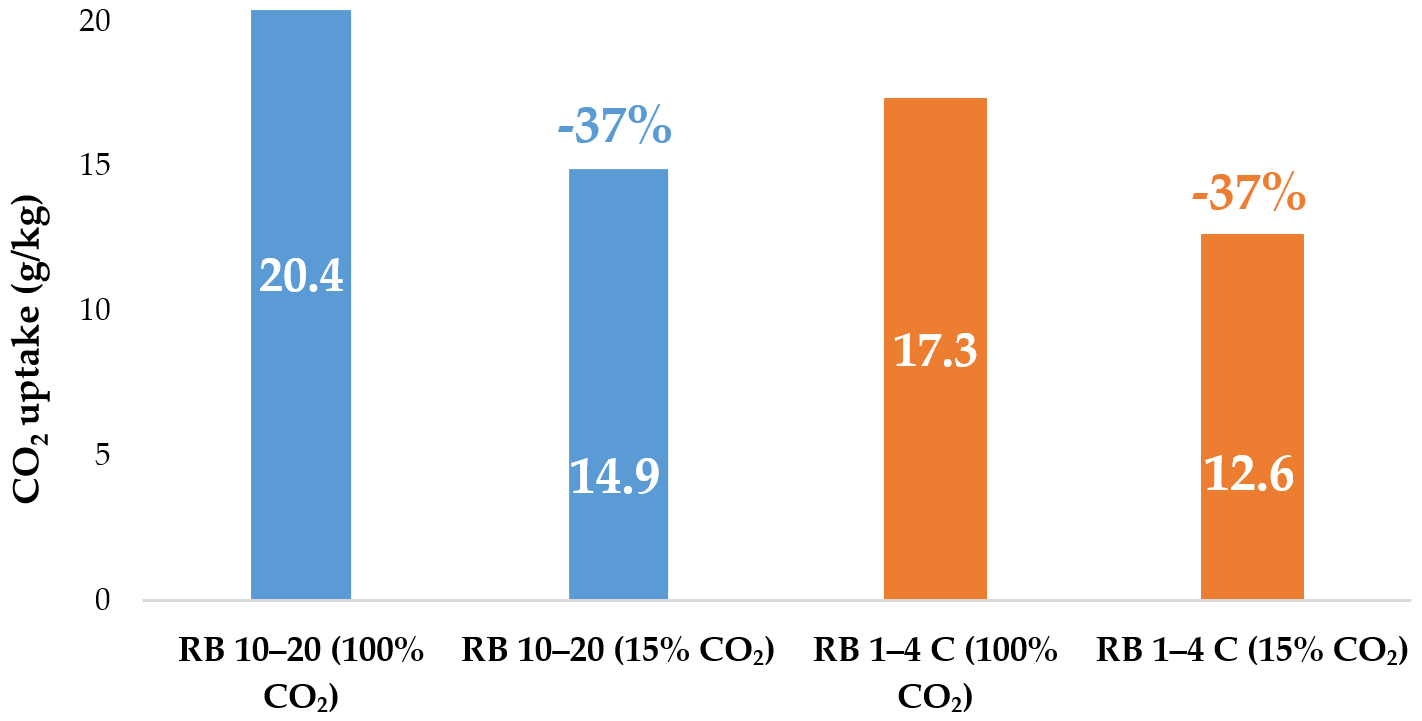
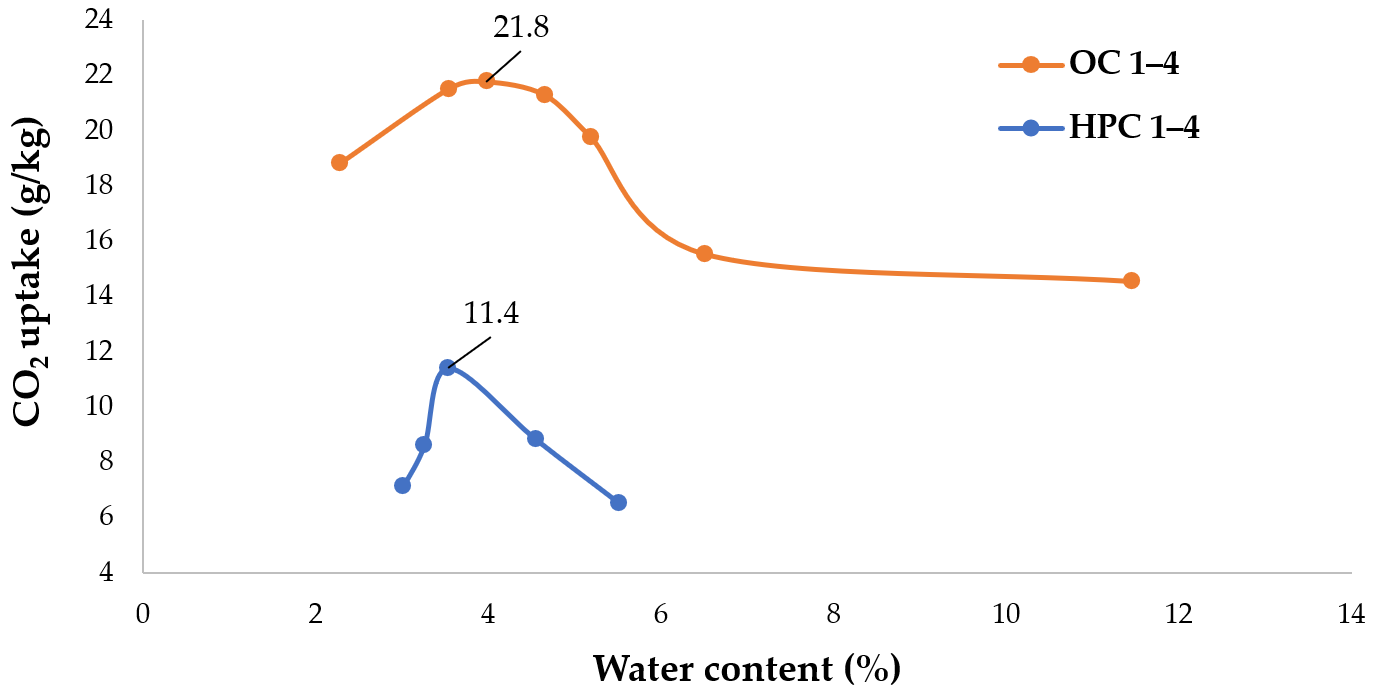
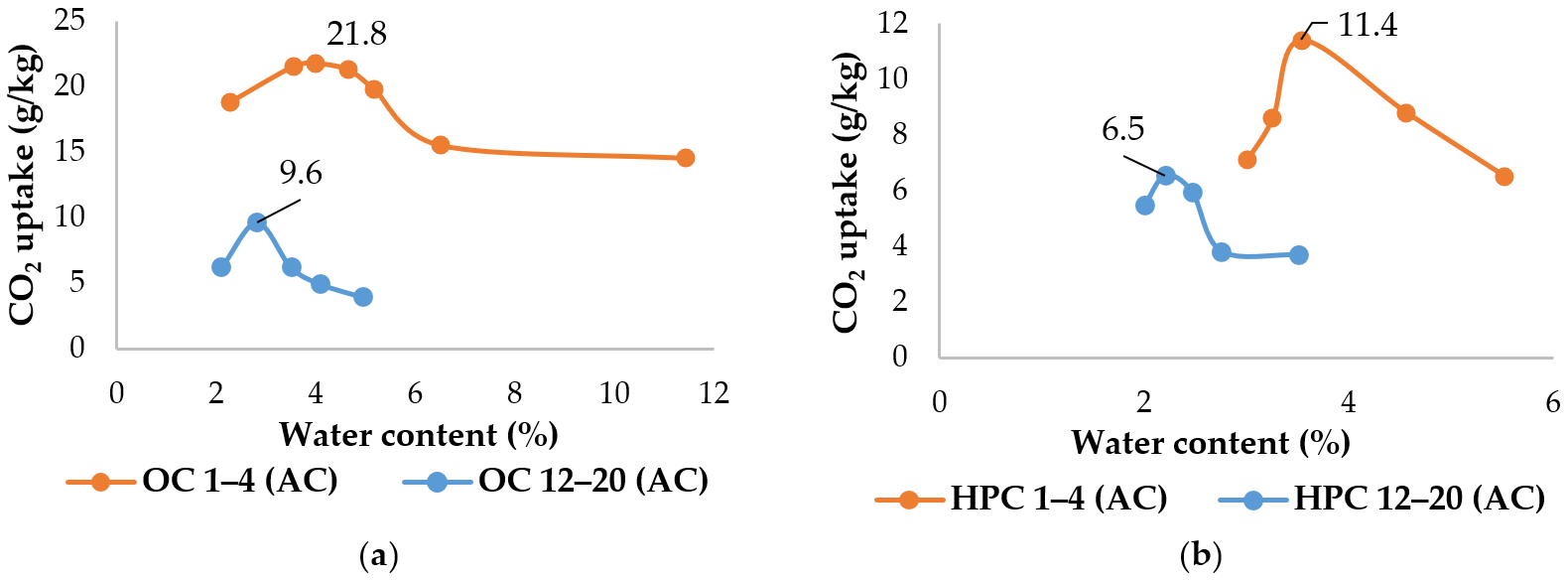
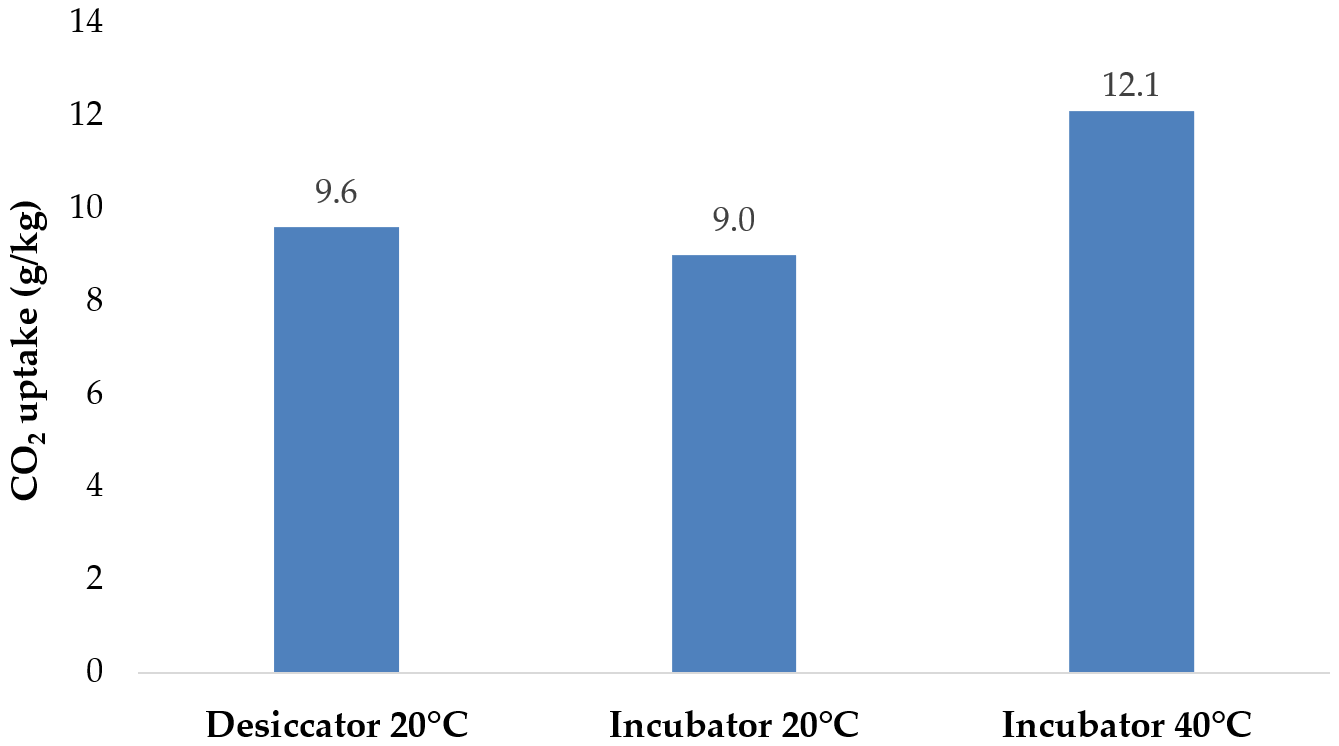
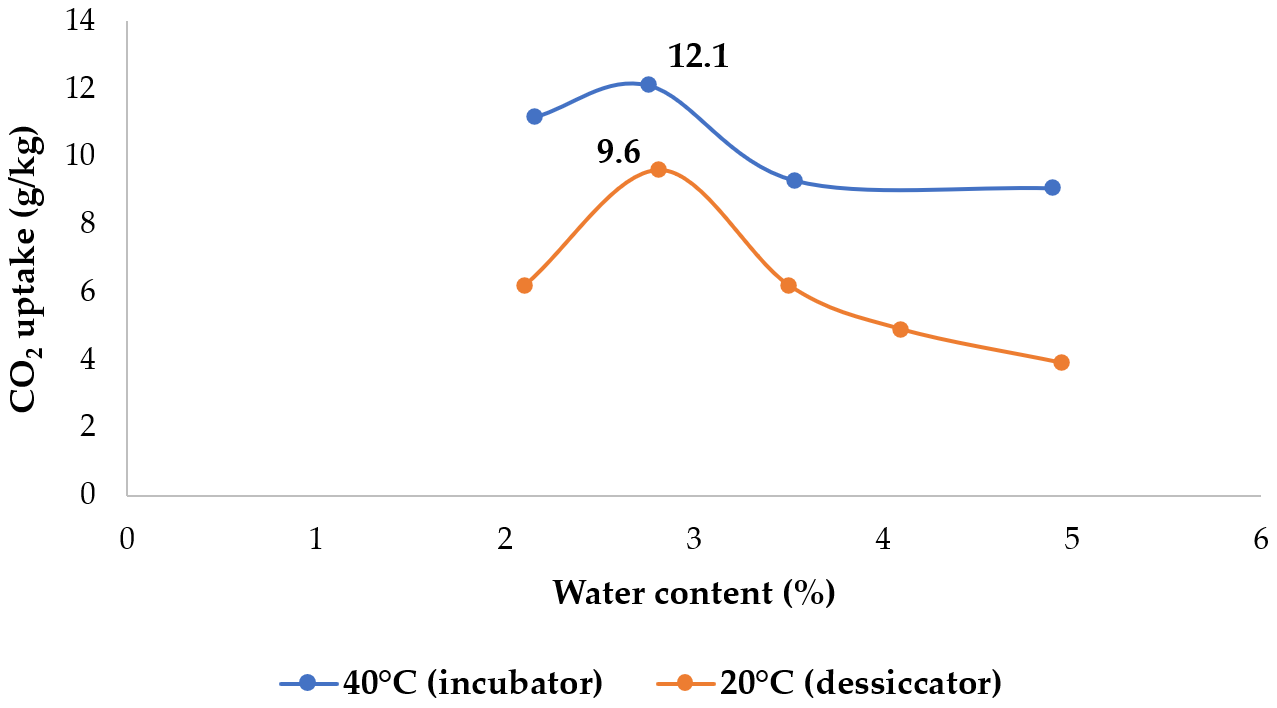



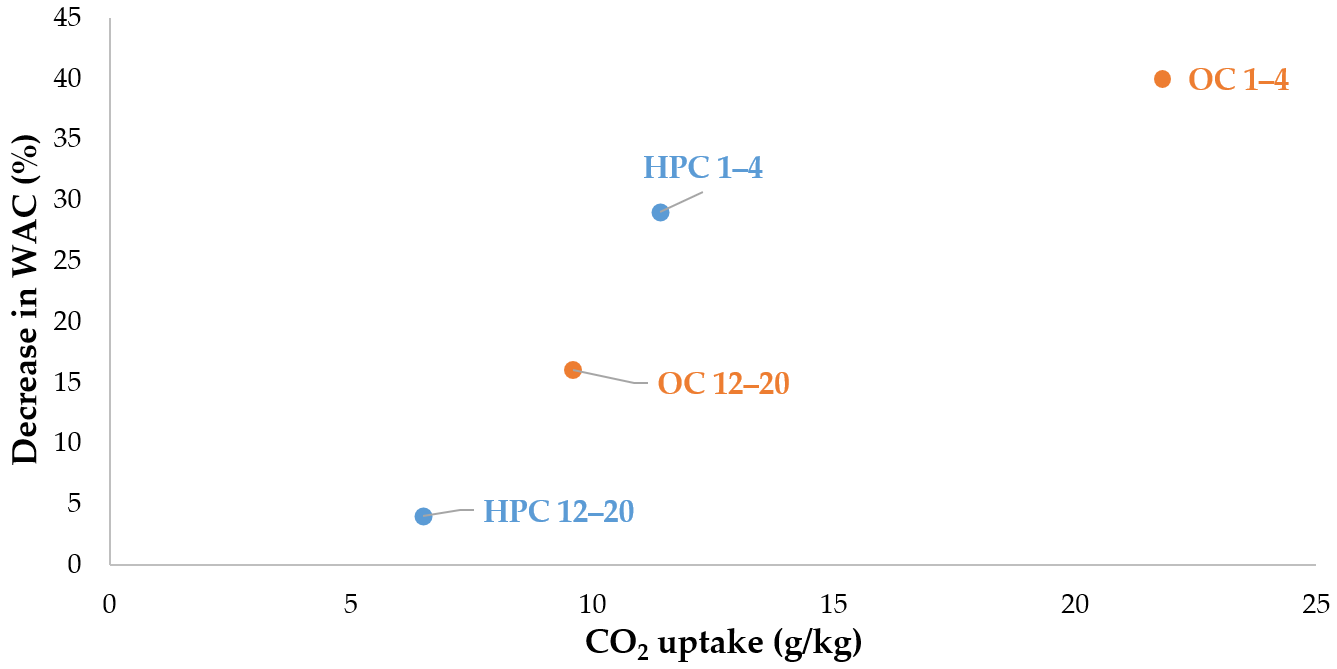

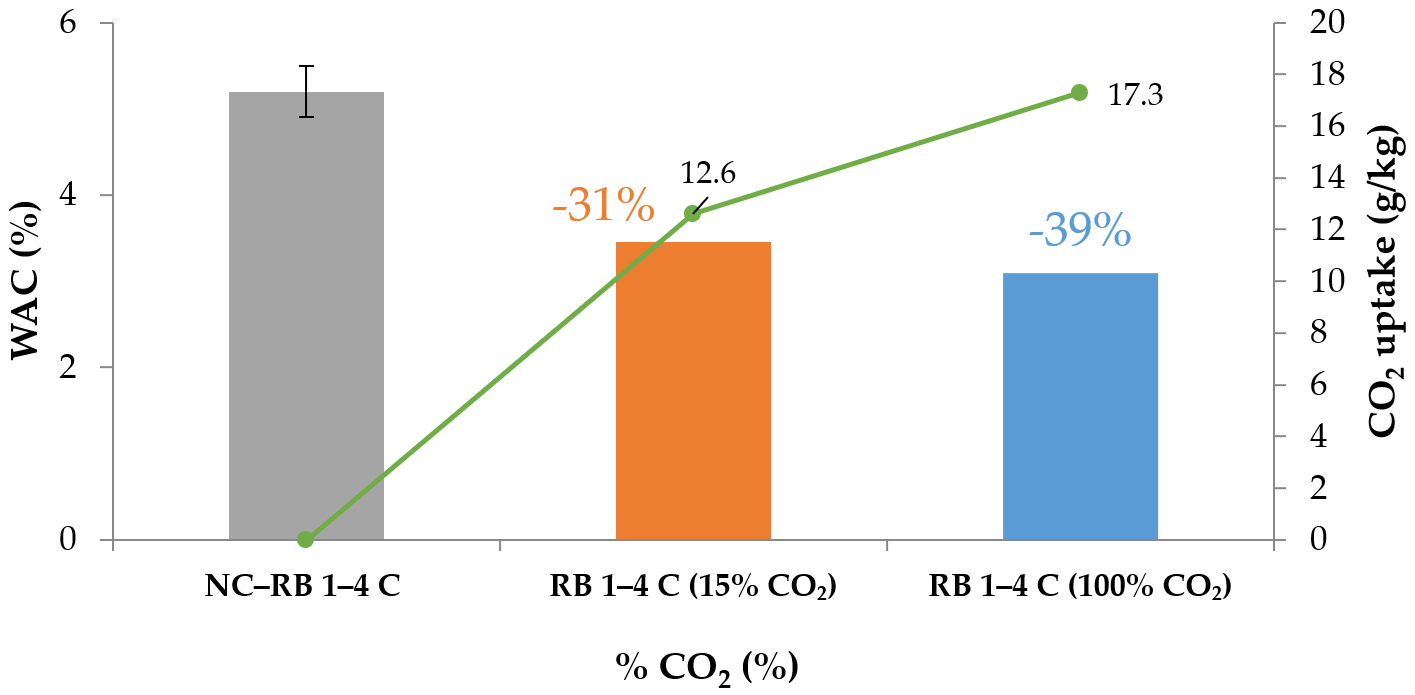

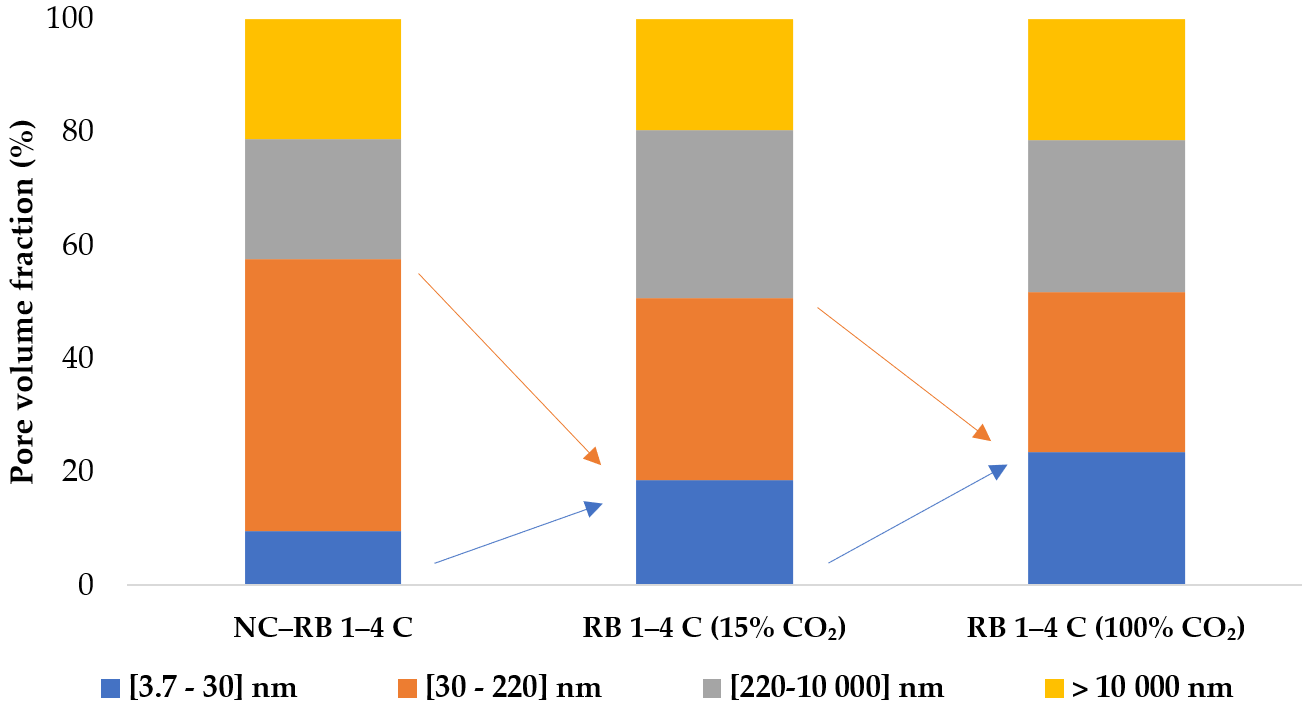
| Constituents (kg/m3) | OC | HPC |
|---|---|---|
| Limestone gravels, 12.5–20 mm | 777 | 550 |
| Limestone gravels, 4–12.5 mm | 415 | 475 |
| Sand (Boulonnais), 0–5 mm | 372 | 407 |
| Sand (Seine), 0–4 mm | 372 | 401 |
| Cement | 353 | 461 |
| Superplasticizer | - | 12.4 |
| Set retarder | - | 3.3 |
| Water | 172 | 146 |
| Water-to-cement ratio | 0.49 | 0.32 |
| 28 d compressive strength (MPa) | 44.5 | 75 |
| Water porosity (%) | 10.9 | 8.5 |
| In % | CaO | SiO2 | Fe2O3 | Al2O3 | TiO2 | MgO | Na2O | K2O | MnO | SO3 | CO2 | Loss in Ignition | Free CaO |
|---|---|---|---|---|---|---|---|---|---|---|---|---|---|
| OC | 66.39 | 21.17 | 1.96 | 2.69 | - | 0.65 | 0.30 | 0.22 | - | 2.43 | 1.56 | 2.26 | 0.84 |
| HPC | 65.38 | 20.54 | 4.13 | 3.59 | 0.19 | 0.86 | 0.18 | 0.29 | 0.07 | 2.67 | 0.88 | 1.24 | - |
| RCA | SFSA (%) | Portlandite Rate (%) | CaCO3 Rate (%) | Porosity (%) | WAC (%) |
|---|---|---|---|---|---|
| NC–RB 1–4 | 21.3 ± 8.4 | ≈0 | 40.8 ± 0.2 | 11.5 ± 0.5 | 4.6 ± 0.5 |
| NC–RB 10–20 | 19.3 ± 7.7 | 1.0 ± 0.1 | 36.1 ± 0.5 | 15.5 ± 0.2 | 7.1 ± 0.1 |
| NC–RB 1–4 C | 26.0 ± 6 | 0.4 ± 0.1 | 35.3 ± 0.3 | 11.4 ± 0.5 | 5.1 ± 0.3 |
| NC–CB 1–4 | 34.0 ± 1.4 | 3.4 ± 0.3 | 46.3 ± 0.5 | 13.8 ± 1.1 | 6.3 ± 0.6 |
| NC–OC 1–4 | 44.9 ± 3.9 | 4.0 ± 0.2 | 61.9 ± 0.4 | 11.7 ± 0.1 | 4.8 ± 0.1 |
| NC–OC 12–20 | 32.1 ± 5.4 | 2.3 ± 0.2 | 66.8 ± 2.1 | 9.20 ± 0.2 | 4.0 ± 0.2 |
| NC–HPC 1–4 | 34.8 ± 5.6 | 2.3 ± 0.2 | 62.0 ± 0.3 | 10.4 ± 0.1 | 4.0 ± 0.4 |
| NC–HPC 12–20 | 33.9 ± 1.2 | 2.1 ± 0.1 | 62.1 ± 3.6 | 8.6 ± 0.2 | 3.6 ± 0.3 |
| CB 1–4 | RB 1–4 C | RB 1–4 | |
|---|---|---|---|
| CO2 concentration (%) | 100% | 100% | 100% |
| Initial natural carbonation | - 1 | + 1 | ++ 1 |
| Optimum water content (%) | 5.4 | 5.2 | 7.2 |
| CO2 uptake (g/kg) | 49.9 | 17.3 | 8.6 |
| RB 1–4 | RB 10–20 (15% CO2) | RB 10–20 (100% CO2) | RB 1–4 C (15% CO2) | RB 1–4 C (100% CO2) | CB 1–4 | |
|---|---|---|---|---|---|---|
| CO2 uptake (g/kg) | 8.6 | 14.9 | 20.4 | 12.6 | 17.3 | 49.9 |
| SFSA (%) | 17.1 ± 7.1 | 17.9 ± 2.9 | 12.8 ± 8.2 | 20.3 ± 6.4 | 14.8 ± 5.9 | 23.1 ± 3.8 |
| Portlandite rate (%) | ≈0 | ≈0 | ≈0 | 0.4 ± 0.1 | ≈0 | 0.7 ± 0.1 |
| CaCO3 rate (%) | 41.5 ± 0.2 | 37.2 ± 0.1 | 47.0 ± 0.3 | 40.4 ± 0.5 | 34.5 ± 0.4 | 37.2 ± 0.4 |
| Porosity (%) | 6.7 | 13.2 | 14.7 | - | - | - |
| WAC (%) | 2.8 | 6.7 | 6.6 | 3.5 | 3.1 | 3.0 |
| OC 1–4 | OC 12–20 | HPC 1–4 | HPC 12–20 | |
|---|---|---|---|---|
| CO2 uptake (g/kg) | 21.8 | 9.6 | 11.4 | 6.5 |
| SFSA (%) | 29.8 ± 4.0 | 24.8 ± 4.6 | 27.1 ± 6.9 | 28.8 ± 9.7 |
| Portlandite rate (%) | 1.3 ± 0.1 | 1.7 ± 0.1 | 1.2 ± 0.1 | 1.4 ± 0.1 |
| CaCO3 rate (%) | 67.9 ± 0.5 | 67.4 ± 0.3 | 64.9 ± 0.3 | 64.0 ± 0.1 |
| Porosity (%) | 7.6 | 6.3 | 7.2 | 8.4 |
| WAC (%) | 2.9 | 3.4 | 2.9 | 3.5 |
Publisher’s Note: MDPI stays neutral with regard to jurisdictional claims in published maps and institutional affiliations. |
© 2021 by the authors. Licensee MDPI, Basel, Switzerland. This article is an open access article distributed under the terms and conditions of the Creative Commons Attribution (CC BY) license (https://creativecommons.org/licenses/by/4.0/).
Share and Cite
Sereng, M.; Djerbi, A.; Metalssi, O.O.; Dangla, P.; Torrenti, J.-M. Improvement of Recycled Aggregates Properties by Means of CO2 Uptake. Appl. Sci. 2021, 11, 6571. https://doi.org/10.3390/app11146571
Sereng M, Djerbi A, Metalssi OO, Dangla P, Torrenti J-M. Improvement of Recycled Aggregates Properties by Means of CO2 Uptake. Applied Sciences. 2021; 11(14):6571. https://doi.org/10.3390/app11146571
Chicago/Turabian StyleSereng, Marie, Assia Djerbi, Othman Omikrine Metalssi, Patrick Dangla, and Jean-Michel Torrenti. 2021. "Improvement of Recycled Aggregates Properties by Means of CO2 Uptake" Applied Sciences 11, no. 14: 6571. https://doi.org/10.3390/app11146571





